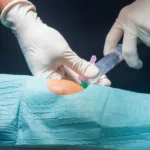

According to the Arthritis Foundation, shoulder osteoarthritis (OA), while less common than knee or hip OA, affects nearly one in three people over 60. This prevalence underscores the reality that aging often brings limited shoulder mobility, impacting quality of life.
Shoulder osteoarthritis (OA) typically manifests as pain, stiffness, and a restricted range of motion in the affected joint. This joint condition can significantly impact an individual’s quality of life, prompting them to explore effective treatments for their symptoms. Synvisc, a type of viscosupplement, can offer these individuals relief from the symptoms of shoulder OA.
This article will delve into shoulder OA condition, Synvsic for shoulders, patient selection criteria, administration techniques, and the safety and efficacy of this injection therapy.
Key Takeaways
- Shoulder osteoarthritis (OA) is the gradual wearing of the articular cartilage, leading to pain, stiffness, and limited movement
- While Synvisc may not have specific indications for the shoulders, viscosupplementation or HA injections have undergone clinical studies that have proven their safety and efficacy in addressing OA concerns in various joints.
- After understanding the warnings and selection criteria for a safe treatment, medical professionals must know and utilize the appropriate administration and dosage of Synvisc injections for patients.
- Providers should discuss the entire Synvisc treatment with patients, allowing them to understand the benefits, potential risks, and its temporary solution for OA concerns.
About: Medica Depot is your trusted all-in-one supplier, offering a range of high-quality medical injectables and supplies. If you’re looking to buy Synvisc, you can do so on Medica Depot quickly and easily. We offer a worry-free experience in searching for the best and most popular products on the market. Whether for health professionals, plastic surgeons, dermatologists, licensed estheticians, or other specialists, we can offer genuine, brand-name products you may need. With Medica Depot, we prioritize serving you better to improve the patient’s quality of life.
Understanding Shoulder Osteoarthritis

Osteoarthritis (OA) is a degenerative joint disease that affects various joints. OA occurs when the cartilage wears down, causing friction and inflammation. Specifically, when shoulder OA affects individuals, it can lead to potential chronic pain, stiffness, and limited movement.
Shoulder OA is defined as a gradual wearing of the articular cartilage, leading to various symptoms. This degenerative joint disease often occurs in individuals aged 60 or older and is less prevalent than knee OA. Several factors may contribute to shoulder OA’s worsening or development.
- Age
- History of Shoulder Injury
- Family History of OA
- Obesity
- Inflammation
- Excessive Wearing Down of Joint
The amount of cartilage loss may vary from one patient to another. Moreover, patients must seek medical professionals’ guidance to get diagnosed and receive proper health care. They may ask for your experiences to help them assess your shoulder OA condition. According to Hopkins Medicine, the primary shoulder OA symptoms include the following:
- Pain in the Shoulder Joint
- Stiffness in the Joint
- Grinding, Clicking, or Cracking
These symptoms significantly reduce individuals’ quality of life, making movement painful and difficult. This leads to a halt in people’s daily activities at home or work, potentially affecting their mental health, sleeping habits, and social relationships.
Introduction to Synvisc
Synvisc is known for its safe and effective solution to knee pain caused by osteoarthritis (OA). According to Synvisc, it has a specific indication for treating pain in knee OA in patients who have failed to respond adequately to conservative nonpharmacologic therapy and simple analgesics.
Viscosupplementation involves administering hyaluronic acid (HA) injections directly into the affected joints. Synvisc is a viscosupplement that supplements the joint’s synovial fluid with HA, enabling adequate lubrication and cushioning.
Like other viscosupplementation treatments, Synvisc’s primary mechanism of action is restoring the physiologic viscoelasticity in the synovial fluid. The injection therapy works as a lubricant and shock absorber for the joints, enabling bones to move smoothly over each other pain-free. It provides symptomatic relief, reducing joint pain, stiffness, and swelling.
It’s worth noting that the US Food and Drug Administration has only approved Synvisc for knee joints and knee OA. However, because HA is a safe substance injected into the body, Synvisc can potentially aid in shoulder OA.
While Synvisc may not have specific indications for the shoulders, viscosupplementation or HA injections have undergone clinical studies that have proven their safety and efficacy in addressing OA concerns in various joints. However, patients should always seek a medical professional’s guidance to understand the treatment and ensure a secure and efficient procedure.
Administering Synvisc in Shoulder Joints

Medical professionals may only recommend Synvisc knee injections when first-line therapies fail to provide relief to patients. In administering Synvisc for shoulders or other joints, x-ray or ultrasound guidance can help healthcare providers ensure accurate needle placement, providing optimal relief outcomes.
A patient-centric approach allows providers to align Synvisc or Synvisc One dosage and injections to the patient’s needs, goals, osteoarthritis (OA) condition, medical history, and overall health. Moreover, Synvisc has several patient selection criteria that can aid medical professionals in determining if the injection therapy suits the patient.
- Patients with early to severe OA, except those who are candidates for surgical interventions.
- Do not administer Synvisc to patients with hypersensitivity or allergy to hyaluronate properties.
- Do not administer Synvisc to patients with hypersensitivity or allergy to avian products.
- Do not inject Synvisc in patients having joint infections, skin diseases, or infections in the area of the injection site.
- The Synvisc manufacturer has yet to establish the safety and efficacy of Synvisc for pregnant women, breastfeeding women, and children under 21.
After understanding the warnings and selection criteria for a safe treatment, medical professionals must know and utilize the appropriate administration and dosage of Synvisc injections for patients. This can lead to maximizing the therapy’s benefits and avoiding potential risks.
- Proper Injection Technique: Before injection, medical professionals must remove joint effusion to avoid other complications. According to Synvisc’s prescribing information, the procedure requires a strict aseptic injection technique for the knee joint. The shoulder joint may also adhere to the same method, and healthcare providers can ensure patients have safe off-table therapy.
- Specific Synvisc or Synvisc One Dosage: A typical Synvisc dosage for the knee joint is 2 mL, while a Synvisc One dosage needs 6 mL. Synvisc needs three injections to complete a cycle, given at one-week intervals, while Synvisc One is a single-injection treatment. Providers can align the dosage to the patient’s shoulder needs and goals.
Like other medications, patients can also expect occurrences of side effects after Synvisc injections. While no resources reported Synvisc for shoulders common side effects, the reactions may be similar to the post-knee joint injection symptoms. When these symptoms persist, immediately seek medical attention.
- Pain
- Swelling
- Heat
- Redness
- Fluid build-up
Incorporating Synvisc into Shoulder Osteoarthritis Treatment


Medical professionals may suggest integrating Synvisc with other treatment modalities, such as physical therapy and pain relief medication. This combination approach can provide comprehensive treatment that offers optimal patient outcomes. Providers’ expertise can significantly help this integration as skillful navigation and coordination are required to maximize the benefits.
Furthermore, providers should discuss the entire Synvisc treatment with patients, allowing them to understand the benefits, potential risks, and its temporary solution for osteoarthritis (OA) concerns. Patients only need several minutes to complete an injection session and may be advised to avoid knee-stressing activities for 48 hours post-injection.
A doctor-patient consultation can help set realistic expectations, increasing patient satisfaction after treatment. Regular monitoring after a cycle allows medical professionals to assess the patient’s treatment response, manage side effect occurrence, and suggest repeat injections after six months if necessary.
Conclusion
Shoulder osteoarthritis (OA) is a degenerative joint disease that can significantly impact a person’s quality of life. Viscosupplementation treatments like Synvisc can provide lubrication and shock absorption for the affected joint, relieve symptomatic pain, and improve joint movement. It’s worth noting that Synvisc only has indications for the knee joint and knee OA, but several providers may offer Synvisc for shoulders as an off-label solution.
Providers can ensure a safe and effective Synvisc therapy, as they know the proper administration techniques and can discuss the procedure with each patient. They can align Synvisc injection and dosage to the patient’s needs, goals, OA condition, and health. Synvisc can enhance shoulder OA management with providers’ expertise, potentially offering a better quality of life.
FAQs
1. What is Synvisc, and how does it work for shoulder osteoarthritis?
Synvisc is a viscosupplement that supplements the joint’s synovial fluid with hyaluronic acid (HA), which lubricates and cushions joints. Synvisc reduces joint pain, stiffness, and swelling in shoulder osteoarthritis patients by providing symptomatic relief.
2. Can Synvisc treat shoulder osteoarthritis?
Although the US Food and Drug Administration has only approved Synvisc for knee joints and osteoarthritis, viscosupplementation or HA injections have undergone clinical studies proving their safety and efficacy in addressing osteoarthritis concerns in various joints, including shoulders.
3. Who can be a candidate for Synvisc therapy for shoulder osteoarthritis?
Patients with early to severe shoulder osteoarthritis, except those candidates for surgical interventions, can be potential candidates for Synvisc therapy. However, medical professionals should ensure accurate needle placement and align Synvisc dosage and injections to the patient’s needs, goals, medical history, and overall health.
References
- Osteoarthritis of the Shoulder. (n.d.). www.arthritis.org. https://www.arthritis.org/diseases/more-about/osteoarthritis-of-the-shoulder
- Get answers to your questions about SYNVISC. (n.d.). Synvisc One; Sanofi. Retrieved May 1, 2024, from https://www.synviscone.com/what-is-synvisc-one/synvisc-faqs
Aesthetic supplies USA refers to products and equipment used in the field of aesthetic medicine and cosmetic treatments that are available for purchase in the United States. These supplies encompass a wide range of items necessary for various aesthetic procedures and treatments conducted by professionals such as dermatologists, plastic surgeons, aestheticians, and other qualified practitioners.
Examples of aesthetic supplies include:
-
Dermal Fillers: Injectable substances used to restore volume and reduce wrinkles.
-
Botulinum Toxin (Botox): Injectables used to temporarily relax facial muscles and reduce wrinkles.
-
Laser Devices: Equipment used for hair removal, skin rejuvenation, tattoo removal, and other laser treatments.
-
Chemical Peels: Solutions applied to the skin to exfoliate and improve texture.
-
Microdermabrasion Devices: Tools used for mechanical exfoliation to rejuvenate skin.
-
Microneedling Devices: Devices that create tiny punctures in the skin to stimulate collagen production.
-
Cosmeceuticals: Skincare products that contain biologically active ingredients with pharmaceutical-like benefits.
-
Sterilization and Disinfection Products: Essential for maintaining hygiene and preventing infections in clinical settings.



